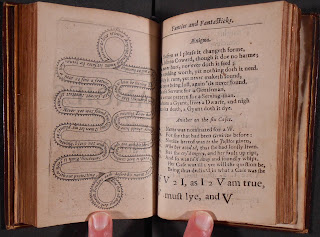 We generally try to stay away from the obsessive intricacies of the rare book world in this blog--preferring to regale you with charming vignettes or shock you with sordid tales from our collections. But today, while looking at the silliest of books, we fell into a bibliographic curiosity that we will now bore you with. Wait, how can a post about book with the title Recreation for Ingenious Head-peeces, Or, a Pleasant Grove for the Wits to Walk in be boring?! This is a book filled with shape poems, witty epigrams, and "numerous Fantasticks!"
We generally try to stay away from the obsessive intricacies of the rare book world in this blog--preferring to regale you with charming vignettes or shock you with sordid tales from our collections. But today, while looking at the silliest of books, we fell into a bibliographic curiosity that we will now bore you with. Wait, how can a post about book with the title Recreation for Ingenious Head-peeces, Or, a Pleasant Grove for the Wits to Walk in be boring?! This is a book filled with shape poems, witty epigrams, and "numerous Fantasticks!"It was those shape poems that aroused our curiosity; not so much their shapes, but how they were printed. Each one is an engraving that has been printed using an intaglio process, a completely different process from the accompanying text, which was printed in relief with raised metal type. This means that the printer could not have printed the images at the same time as the text. That is not a big deal--it happens all of the time in the 17th century. Usually the engraved pages are special plates printed out of sequence with the text block signatures and then bound in separately. We are starting to bore you, aren't we?
Not to worry, here is where it gets exciting! All of the engraved pages appear in the same signature (Q) between signatures P and R. Most of the pages in the signature are type, but four pages are engraved. Not only that, but the entire book is an octavo in 8s except for this signature which is an octavo in 12s. "Wow!" you say, "this is exciting!" You're right. That signature, with its 12 leaves, has four engraved pages. In each case, they are on the same leaf with text on the other side. So, it looks like the printer took a half sheet, printed one side using using an intaglio process and the other side with a relief process. At least that's what we think--it is really hard to tell for sure without disbinding the thing. Also, he seems to have folded it incorrectly so the pages are out of order. It is a mess, bibliographically. This took some planning by a printer who wanted to make his "Fantasticks" fantastic. He was smart enough to place all of the fancy work in this one signature so he could print the rest more easily, but why he didn't go with plates is anyone's guess.
To try to puzzle it out, ask for Rare PR2308 .W58 1654.

No comments :
Post a Comment